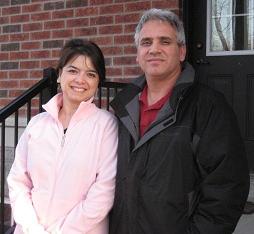Geothermal Heating & Cooling
Green Success Stories - Mammone Family
Green Basics Advanced Green Steps Speaking Green Success Stories

Green Basics Advanced Green Steps Speaking Green Success Stories
|
Home > Green Success Stories > Geothermal Heating and Cooling |
 As published by the Brooklin Town Crier - March 26, 2010
As published by the Brooklin Town Crier - March 26, 2010
by Scott Bennett
What is the most efficient way to heat or cool your home? Sal and Sandra Mammone know - it's geothermal heating and cooling. One day while visiting the library, I was speaking with Sandra, who is the Brooklin Branch Supervisor. During the conversation, she mentioned that their house was heated using geothermal technology. I just had to find out more about it.
 Several years ago, Sal and Sandra decided to build a home on a 35 acre lot near Myrtle. One of the decisions they had to make was if they would have a gas line installed to heat their home and hot water. After looking at the cost and comparing their heating options, Sal was interested in geothermal. Sandra was not so sure. They decided to go to a farmhouse in northeast Oshawa that was using a geothermal system. After that visit, they were convinced that geothermal heating was the way to go, and they contracted Earth Heat to do the installation.
Several years ago, Sal and Sandra decided to build a home on a 35 acre lot near Myrtle. One of the decisions they had to make was if they would have a gas line installed to heat their home and hot water. After looking at the cost and comparing their heating options, Sal was interested in geothermal. Sandra was not so sure. They decided to go to a farmhouse in northeast Oshawa that was using a geothermal system. After that visit, they were convinced that geothermal heating was the way to go, and they contracted Earth Heat to do the installation.
How does geothermal work? Underground, the earth is a constant 10 to 15 degrees celsius. Geothermal technology uses that constant temperature to either heat or cool the home with the use of a heat pump. Pipes are installed in the ground and liquid is circulated through them to either extract heat from the ground or to cool the home by removing the heat from the house. The only energy required is the electricity to run the heat pump and the furnace fan. The whole system is 40 to50% more energy efficient than the average furnace.
Because Sal has a lot of space around his home, he was able to install a horizontal loop system in which trenches are dug six feet underground for the circulating pipes. For his 3,600 square foot home, there were six trenches dug, each about 275 feet long.
For subdivision lots, vertical loops are better suited to the smaller space, and several holes are drilled approximately 200 feet deep. I talked with Logan, the geothermal install manager for Earth Heat, who told me a vertical loop system for a 1,500 square foot home would cost approximately $16,000 (after factoring in $8,700 in government retrofit grants).
I was so impressed that Sal and Sandra's home is heated only by geothermal heating. All of the tile floors in the kitchen, hallway, and bathroom are heated using radiant in-floor heating. The remainder of the house is heated or cooled with forced air ducts, similar to most homes.
Sal also told me that his geothermal system pre-heats water for their electric hot water tank. This reduces water heating costs by about 50%. The system is also setup to heat a hot tub and pool in the future. Not only that, but the basement floor and garage floor are heated too! At this point, I started to get green with envy - my garage workshop is cold in the winter.
Now that they've been in their home for two years, Sal and Sandra don't regret their decision at all. They have never had a problem with the house being too cold in the winter. In fact, recently they had a New Year's party in their basement and had to open the windows it was so warm. Sal has recommended geothermal to several people, who have since installed their own systems. "It's difficult for people to understand until they see it," he says. But his referrals prove that it's a winning solution. It's comfortable, it's the most energy-efficient way to heat, and it's green.
When I asked Sal what his next project will be, he said, "I like the idea of going off grid, so I want to look into wind and solar electricity." I enjoyed my visit with Sal and Sandra to learn about their green home. This is an inspiring, green success story that demonstrates a green choice can be a comfortable choice too.
If you would like to know more about geothermal heating for your home, you can contact Earth Heat at 905.697.0004 or visit www.earthheat.ca.
For more ideas on how to go green, see our green tips for heating and cooling.
Related Green Success Stories
On Demand Water Heater
Solar Water Heater
Green Home - Geothermal & Solar
Solar Rooftop Success Story
Durham Eco-House